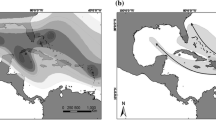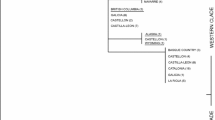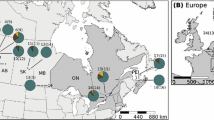Abstract
Spread of the invasive cactus-feeding moth Cactoblastis cactorum has been well documented since its export from Argentina to Australia as a biocontrol agent, and records suggest that all non-native populations are derived from a single collection in the moth’s native range. The subsequent global spread of the moth has been complex, and previous research has suggested multiple introductions into North America. There exists the possibility of additional emigrations from the native range in nursery stock during the late twentieth century. Here, we present mitochondrial gene sequence data (COI) from South America (native range) and North America (invasive range) to test the hypothesis that the rapid invasive spread in North America is enhanced by unique genetic combinations from isolated portions of the native range. We found that haplotype richness in the native range of C. cactorum is high and that there was 90% lower richness in Florida than in Argentina. All Florida C. cactorum haplotypes are represented in a single, well-defined clade, which includes collections from the reported region of original export from Argentina. Thus, our data are consistent with the documented history suggesting a single exportation of C. cactorum from the eastern region of the native range. Additionally, the presence of geographic structure in three distinct haplotypes within the same clade across Florida supports the hypothesis of multiple introductions into Florida from a location outside the native range. Because the common haplotypes in Florida are also known to occur in the neighboring Caribbean Islands, the islands are a likely source for independent North American colonization events. Our data show that rapid and successful invasion within North America cannot be attributed to unique genetic combinations. This suggests that successful invasion of the southeastern US is more likely the product of a fortuitous introduction into favorable abiotic conditions and/or defense responses of specific Opuntia hosts, rapid adaptation, or a release from native enemies.




Similar content being viewed by others
References
Annecke DP, Moran VC (1978) Critical reviews of biological pest control in South Africa. 2. The prickly pear, Opuntia ficus-indica (L.) Miller. J Entomol Soc S Afr 41:161–188
Baker AJ, Stiling P (2009) Comparing the effects of the exotic cactus-feeding moth, Cactoblastis cactorum (Berg) (Lepidoptera: Pyralidae) and the native cactus-feeding moth, Melitara prodenialis (Walker) (Lepidoptera: Pyralidae) on two species of Florida Opuntia. Biol Invasions 11:619–624
Boman S, Grapputo A, Lindström L, Lyytinen A, Mappes J (2008) Quantitative genetic approach for assessing invasiveness: geographic and genetic variation in life-history traits. Biol Invasions 10:1135–1145
Caterino MS, Sperling FAH (1999) Papilio phylogeny based on mitochondrial cytochrome oxidase I and II genes. Mol Phylogenet Evol 11:122–137
Dickel TS (1991) Cactoblastis cactorum in Florida (Lepidoptera: Pyralidae: Phycitinae). Trop Lepid 2:117–118
Dlugosch KM, Parker IM (2008a) Founding events in species invasions: genetic variation, adaptive evolution, and the role of multiple introductions. Mol Ecol 17:431–449
Dlugosch KM, Parker IM (2008b) Invading populations of an ornamental shrub show rapid life history evolution despite genetic bottlenecks. Ecol Lett 11:701–709
Dodd AP (1927) The biological control of prickly pear in Australia. Commonwealth Council for Scientific and Industrial Research, Bulletin no. 34, Melbourne, Australia
Dodd AP (1940) The biological campaign against prickly-pear. Commonwealth Prickly Pear Board, Brisbane
Excoffier L, Smouse P, Quattro J (1992) Analysis of molecular variance inferred from metric distances among DNA haplotypes: application to human mitochondrial DNA restriction data. Genetics 131:479–491
Excoffier L, Laval G, Schneider S (2005) Arlequin ver. 3.0: an integrated software package for population genetics data analysis. Evol Bioinform Online 1:47–50
Foxcroft LC, Hoffmann JH, Viljoen JJ, Kotze JJ (2007) Factors influencing the distribution of Cactoblastis cactorum, a biological control agent of Opuntia stricta in Kruger National Park, South Africa. S Afr J Bot 73:113–117
Frankham R (2005) Resolving the genetic paradox in invasive species. Heredity 94:385
Fritts TH, Rodda GH (1998) The role of introduced species in the degradation of island ecosystems: a case history of Guam. Annu Rev Ecol Syst 29:113–140
Griffin GJ (2000) Blight control and restoration of the American chestnut. J For 98:22–27
Habeck DH, Bennett FD (1990) Cactoblastis cactorum Berg (Lepidoptera: Pyralidae), a Phycitine new to Florida. Entomology Circular No. 333, Florida Department of Agriculture and Consumer Services, Division of Plant Industry
Hight SD, Carpenter JE, Bloem KA, Bloem S, Pemberton RW, Stiling P (2002) Expanding geographical range of Cactoblastis cactorum (Lepidoptera: Pyralidae) in North America. Fla Entomol 85:527–529
Hoffmann JH, Moran VC, Zeller DA (1998a) Evaluation of Cactoblastis cactorum (Lepidoptera: Phycitidae) as a biological control agent of Opuntia stricta (Cactaceae) in the Kruger National Park, South Africa. Biol Control 12:20–24
Hoffmann JH, Moran VC, Zeller DA (1998b) Long-term population studies and the development of an integrated management programme for control of Opuntia stricta in Kruger National Park, South Africa. J Appl Ecol 35:156–160
Holland BS (2000) Genetics of marine bioinvasions. Hydrobiologia 420:63–71
Holland BS (2001) Invasion without a bottleneck: microsatellite variation in natural and invasive populations of the brown mussel, Perna perna (L.). Mar Biotechnol 3:407–415
Huelsenbeck JP, Ronquist F (2001) MRBAYES: Bayesian inference of phylogenetic trees. Bioinformatics 17:754–755
Johnson DM, Stiling PD (1996) Host specificity of Cactoblastis cactorum (Lepidoptera: Pyralidae), an exotic Opuntia-feeding moth, in Florida. Environ Entomol 25:743–748
Johnson DM, Stiling PD (1998) Distribution and dispersal of Cactoblastis cactorum (Lepidoptera: Pyralidae), an exotic Opuntia-feeding moth, in Florida. Fla Entomol 81:12–22
Keane RM, Crawley MJ (2002) Exotic plant invasions and the enemy release hypothesis. Trends Ecol Evol 17:164–170
Kolbe JJ, Glor RE, Schettino LR, Lara AC, Larson A, Losos JB (2004) Genetic variation increases during biological invasion by a Cuban lizard. Nature 431:177–181
Lavergne S, Molofsky J (2007) Increased genetic variation and evolutionary potential drive the success of an invasive grass. Proc Natl Acad Sci USA 104:3883–3888
Lee CE (2002) Evolutionary genetics of invasive species. Trends Ecol Evol 17:386–391
Librado P, Rozas J (2009) DnaSP v5: a software for comprehensive analysis of DNA polymorphism data. Bioinformatics 25:1451–1452
Logarzo G, Varone L, Briano J (2008) Cactus moth. 2008 Annual Report. South American Biological Control Laboratory. USDA, ARS, Buenos Aires, Argentina
Meimberg H, Hammond JI, Jorgensen CM, Park TW, Gerlach JD, Rice KJ, McKay JK (2006) Molecular evidence for an extreme genetic bottleneck during introduction of an invading grass to California. Biol Invasions 8:1355–1366
Nei M (1987) Molecular evolutionary genetics. Columbia University Press, New York
Novak SJ (2007) The role of evolution in the invasion process. Proc Natl Acad Sci USA 104:3671–3672
Novak SJ, Mack RN (2005) Genetic bottlenecks in alien species invasions. In: Sax DF, Stachowicz JJ, Gaines SD (eds) Species invasions: insights into ecology, evolution, and biogeography. Sinauer, Sunderland, pp 201–228
Pascual-Hortal L, Saura S (2006) Comparison and development of new graph-based landscape connectivity indices: towards the prioritization of habitat patches and corridors for conservation. Landsc Ecol 21:959–967
Payne JH (2009) US Department of Agriculture—Animal and Plant Health Inspections Services report DA-2009-25. Available via http://www.aphis.usda.gov/plant_health/plant_pest_info/cactoblastis/reports.shtml. Accessed 20 July 2009
Pemberton RW (1995) Cactoblastis cactorum (Lepidoptera: Pyralidae) in the United States: an immigrant biological control agent or an introduction of the nursery trade? Am Entomol 41:230–232
Pemberton RW, Cordo HA (2001a) Nosema (Microsporidia: Nosematidae) species as potential biological control agents of Cactoblastis cactorum (Lepidoptera: Pyralidae): surveys for the microsporidia in Argentina and South Africa. Fla Entomol 84:527–530
Pemberton RW, Cordo HA (2001b) Potential and risks of biological control of Cactoblastis cactorum (Lepidoptera: Pyralidae) in North America. Fla Entomol 84:513–526
Pemberton RW, Liu H (2007) Control and persistence of native Opuntia on Nevis and St. Kitts 50 years after the introduction of Cactoblastis cactorum. Biol Control 41:272–282
Pettey FW (1947) The biological control of prickly pears in South Africa. Department of Agriculture, Science Bulletin 271. Entomology Series No. 22, Pretoria
Pinkava DJ (2003) Opuntia. In: Flora of North America Editorial Committee (ed) Flora of North America north of Mexico, vol 4. Oxford University Press, New York, pp 123–148
Posada D, Crandall KA (1998) MODELTEST: testing the model of DNA substitution. Bioinformatics 14:817–819
Puillandre N, Dupas S, Dangles O, Zeddam J-L, Capdevielle-Dulac C, Barbin K, Torres-Leguizamon M, Silvain J-F (2008) Genetic bottleneck in invasive species: the potato tuber moth adds to the list. Biol Invasions 10:319–333
Raghu S, Walton C (2007) Understanding the ghost of Cactoblastis past: historical clarifications on a poster child of classical biological control. Bioscience 57:699–705
Rannala B, Yang ZH (1996) Probability distribution of molecular evolutionary trees: a new method of phylogenetic inference. J Mol Evol 43:304–311
Reed DH, Frankham R (2001) How closely correlated are molecular and quantitative measures of genetic variation? A meta-analysis. Evolution 55:1095–1103
Reznick DN, Shaw FH, Rodd FH, Shaw RG (1997) Evaluation of the rate of evolution in natural populations of guppies (Poecilia reticulata). Science 275:1934–1937
Roane MK, Griffin GJ, Elkins JR (1986) Chestnut blight, other Endothia diseases and the genus Endothia. APS Press, St. Paul
Roman J, Darling JA (2007) Paradox lost: genetic diversity and the success of aquatic invasions. Trends Ecol Evol 22:454–464
Ronquist F, Huelsenbeck JP (2003) MrBayes 3: Bayesian phylogenetic inference under mixed models. Bioinformatics 19:1572–1574
Ronquist F, Heulsenbeck JP, van der Mark P (2005) MrBayes 3.1 Manual. Available via http://mrbayes.csit.fsu.edu/index.php. Accessed 2 October 2009
Rosenberg MS (2001) PASSAGE. Pattern analysis, spatial statistics, and geographic exegesis. Version 1.1. Department of Biology, Arizona State University, Tempe, AZ
Rubinoff D, Holland BS, Shibata A, Messing RH, Wright MG (2010) Rapid invasion despite lack of genetic variation in the erythrina gall wasp (Quadrastichus erythrinae Kim). Pac Sci 64:23–31
Sauby KE (2009) The ecology of Cactoblastis cactorum (Berg) (Lepidoptera: Pyralidae) in Florida. Master’s thesis, Mississippi State University, Mississippi State, MS
Saura S, Pascual-Hortal L (2007) A new habitat availability index to integrate connectivity in landscape conservation planning: comparison with existing indices and application to a case study. Landsc Urban Plan 83:91–103
Simmonds FJ, Bennett FD (1966) Biological control of Opuntia spp. by Cactoblastis cactorum in the Leeward Islands (West Indies). Entomophaga 11:183–189
Simon C, Frati F, Breckenbach A, Crespi B, Liu H, Flook P (1994) Evolution, weighting, and phylogenetic utility of mitochondrial gene sequences and a compilation of conserved polymerase chain reaction primers. Ann Entomol Soc Am 87:651–701
Simonsen TJ, Brown RL, Sperling FAH (2008) Tracing an invasion: phylogeography of Cactoblastis cactorum (Lepidoptera: Pyralidae) in the United States based on mitochondrial DNA. Ann Entomol Soc Am 101:899–905
Simonson SE, Stohlgren TJ, Tyler L, Gregg WP, Muir R, Garrett LJ (2005) Preliminary assessment of the potential impacts and risks of the invasive cactus moth, Cactoblastis cactorum Berg, in the U.S. and Mexico. Final Report to the International Atomic Energy Agency, IAEA
Suarez AV, Tsutsui ND (2008) The evolutionary consequences of biological invasions. Mol Ecol 17:351–360
Torchin ME, Mitchell CE (2004) Parasites, pathogens, and invasions by plants and animals. Front Ecol Environ 2:183–190
Torchin ME, Lafferty KD, Dobson AP, McKenzie VJ, Kuris AM (2003) Introduced species and their missing parasites. Nature 421:628–630
Wares JP, Hughes AR, Grosberg RK (2005) Mechanisms that drive evolutionary change. In: Sax DF, Stachowicz JJ, Gaines SD (eds) Species invasions: insights into ecology, evolution, and biogeography. Sinauer, Sunderland, pp 229–257
Weir BS (1996) Genetic data analysis II: methods for discrete population genetic data. Sinauer, Sunderland
Weir BS, Cockerham CC (1984) Estimating F-statistics for the analysis of population structure. Evolution 38:1358–1370
Whitney KD, Gabler CA (2008) Rapid evolution in introduced species, ‘invasive traits’ and recipient communities: challenges for predicting invasive potential. Divers Distrib 14:569–580
Zimmerman HG, Sandi y Cuen MP, Rivera AB (2005) The status of Cactoblastis cactorum (Lepidoptera: Pyralidae) in the Caribbean and the likelihood of its spread to Mexico. Report to the IAEA—TC Project MEX/5/029
Acknowledgments
This work was supported in part by grants from the U.S. Geological Survey Biological Resources Discipline (04HQAG0135 and 08HQAG0139) and U.S. Department of Agriculture (2007-55320-17847) to GNE. Additional funds were provided by the Mississippi State University Office of Research and Economic Development and the College of Arts and Sciences. We also thank Guillermo Logarzo and Laura Varone (USDA South American Biological Control Laboratory, Buenos Aires), James Carpenter (USDA-ARS Crop Protection and Management Research Unit, Tifton, GA), Stephen Hight (USDA-ARS Insect Behavior and Biocontrol Research Unit, Gainesville, FL), Kristen Sauby, and Anastasia Woodard for assistance with sample collection. We are grateful to Richard Brown (Mississippi Entomological Museum) who assisted in the identification of some samples. We thank three anonymous reviewers for their comments that improved the manuscript.
Author information
Authors and Affiliations
Corresponding author
Rights and permissions
About this article
Cite this article
Marsico, T.D., Wallace, L.E., Ervin, G.N. et al. Geographic patterns of genetic diversity from the native range of Cactoblastis cactorum (Berg) support the documented history of invasion and multiple introductions for invasive populations. Biol Invasions 13, 857–868 (2011). https://doi.org/10.1007/s10530-010-9874-9
Received:
Accepted:
Published:
Issue Date:
DOI: https://doi.org/10.1007/s10530-010-9874-9




